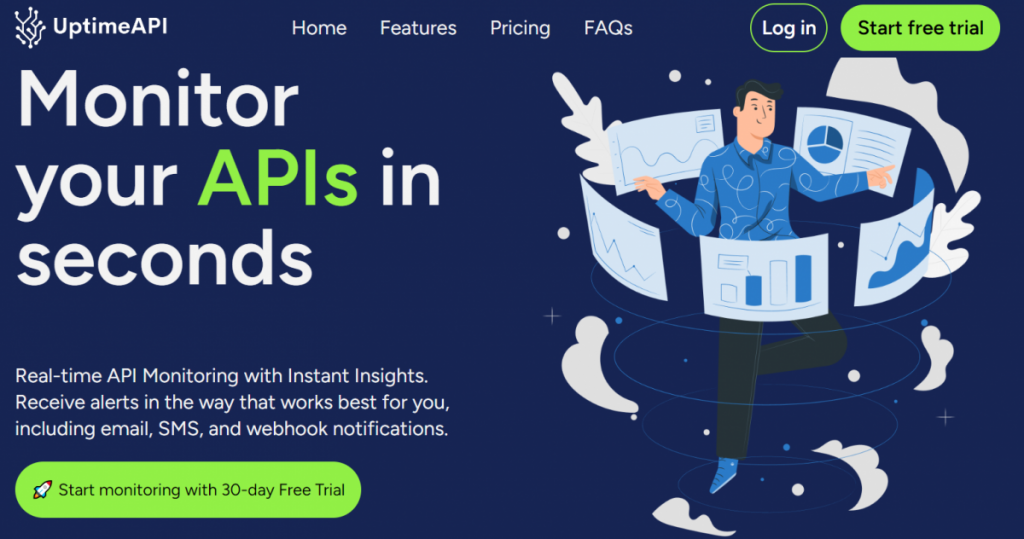In the fast-paced world of digital services, ensuring the reliability and availability of your application programming interface (API) is crucial. Downtime can lead to frustrated users, lost revenue, and damage to your brand reputation. One tool that can help you stay on top of your API’s health is UptimeAPI. In this step-by-step tutorial, we’ll explore how to perform an API health check using UptimeAPI and understand the significance of the API responses.
Getting Started with UptimeAPI:

UptimeAPI is a comprehensive solution designed to monitor the status and performance of your APIs. Before diving into the health check, you’ll need to sign up for an account on the UptimeAPI platform. Once registered, you can create a new monitor specifically for your API.
Step 1: Create a Monitor for Your API
After logging into your UptimeAPI account, navigate to the dashboard and look for the option to create a new monitor. Provide the necessary details such as the API endpoint URL, the monitoring frequency, and any additional settings that align with your specific requirements.
Step 2: Define Monitoring Intervals
Select how frequently UptimeAPI should check the health of your API. The monitoring intervals can range from a few seconds to several minutes. Consider the criticality of your API and the desired level of granularity in monitoring when setting up these intervals.
Step 3: Configure Alerts
UptimeAPI allows you to configure alerts to be notified instantly when your API experiences issues. Set up email, SMS, or webhook alerts to ensure that you’re promptly informed about any disruptions to your API’s service.
Step 4: Analyze Historical Data
UptimeAPI provides historical data on your API’s performance, allowing you to identify patterns and potential issues. Utilize this feature to gain insights into the overall health and reliability of your API over time.
Understanding API Responses:

Now that you’ve set up monitoring for your API, it’s essential to understand the various responses you might encounter during the health check.
- HTTP Status Codes:
- 2xx Success Codes: Indicate that the API request was received, understood, and processed successfully. Examples include 200 OK for a standard request and 204 No Content for a successful request with no data to return.
- 4xx Client Error Codes: Signify issues on the client side, such as 404 Not Found for a resource not found or 401 Unauthorized for unauthorized access attempts.
- 5xx Server Error Codes: Indicate problems on the server side, such as 500 Internal Server Error for unexpected issues during API processing.
- Response Time:
- Monitor the time it takes for your API to respond to requests. A sudden spike in response time could indicate performance issues that need attention.
- Payload Content:
- Check the content of the API response payload. Ensure that it contains the expected data in the correct format. Unexpected or malformed data may indicate issues with your API’s functionality.
- Connection Timeouts:
- Keep an eye on connection timeouts. If your API consistently times out, it may point to infrastructure problems or insufficient resources.
- SSL/TLS Handshake:
- Verify the success of the SSL/TLS handshake. Secure connections are essential for protecting sensitive data during API transactions.
Troubleshooting Common Issues:
Should your API health check reveal problems, consider the following troubleshooting steps:
- Review Error Codes:
- Analyze the specific HTTP status codes received to pinpoint the nature of the issue.
- Check Server Logs:
- Examine server logs to identify any errors or abnormalities that might be impacting your API.
- Monitor Resource Utilization:
- Keep an eye on server resource utilization. High CPU or memory usage could be indicative of performance bottlenecks.
- Scale Infrastructure:
- If your API is consistently under heavy load, consider scaling your infrastructure to handle increased demand.
Conclusion:
Performing regular API health checks using UptimeAPI is a proactive approach to maintaining the reliability and availability of your digital services. By following this step-by-step tutorial, you can ensure that your API remains robust, identify potential issues early, and take corrective actions to deliver a seamless experience for your users. Understanding the nuances of API responses is key to effective monitoring and troubleshooting, allowing you to address issues promptly and maintain the trust of your user base.
Read More: Company profile APIUsage Cases

